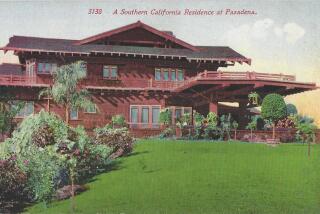Prince Charles’ Vision of an English Village Rises Amid Praise, Ridicule
- Share via
DORCHESTER, England — Iron Age warriors built a fort here. Later, the Romans established a thriving town, and the Normans contributed a castle.
Now Prince Charles is adding a village.
In a fold of emerald countryside along the edge of Dorchester--the setting for Thomas Hardy’s “Mayor of Casterbridge”--the heir to the throne is building his vision of a working village that harks back to the past.
Called Poundbury, it marries traditional design and materials with modern construction and planning techniques to produce an old English village that eventually will be full of stone houses, a pub, tower, inn, small stores, offices and some light industry.
It’s not a universally acclaimed plan. Some architects ridicule it as a poor imitation of a fantasized past, while others question whether it can compete with the cheaper housing of traditional subdivisions.
The first 69 houses on 4 acres owned by the prince’s Duchy of Cornwall at the western edge of Dorchester are now occupied, and 88 more are under construction. A company that makes computer components has moved into restored Victorian farm buildings on the site.
“We are gradually getting to the point where we are creating a proper community,” Charles said in a visit to Poundbury last year.
The Duchy of Cornwall has owned land around Dorchester since 1342. Today, it holds about 2,600 acres of mostly farmland on three sides of the town, which has a population of 15,000--and growing.
Britain, as a whole, needs to build 4.4 million new homes by 2016, a 20% increase in the existing stock. That would consume 650 square miles of farmland if the 1980s pattern of suburban development continues, the Department of Environment says.
While recognizing the need for houses, Charles has urged that rural development “enhance rather than detract from the surrounding landscape.”
At Poundbury, he envisages clusters of traditional, low-rise dwellings interspersed with leisure facilities and small businesses providing work for local people, reducing dependency on cars.
Over the next 20 years, Poundbury is planned to have 2,000 to 3,000 homes spread over 400 acres and to incorporate offices, workshops, a community center, market square and children’s playground.
The first houses are in stone and brick with slate or tile roofs. Unlike the cookie-cutter sameness of most modern subdivisions, each house is different, and they are clustered in groups of five or six. That type of construction costs 10% more than ordinary housing, builders say.
The row houses on Stowcastle curve into neo-Georgian Flintcomb Square, which gives onto narrow, winding Pitcote Lane. Parking areas and garages are kept out of sight.
“Every vista is harmonious and every building has the charm of a different age, except for the unnatural newness of materials, which will mellow in time,” wrote Christine Webb, real estate writer for the national newspaper The Times.
But Tom Rowland, real estate writer for The Telegraph, considers Poundbury “mostly a failure,” pointing to the small number of houses that have been occupied since the plan was first announced a decade ago.
The “more likely shape of the brave new Britain” is Whiteley, near the port of Southampton, which has streets of similar houses surrounding “an all-singing, all-dancing shopping mall,” Rowland wrote recently.
Kiloran McGrigor, spokeswoman for the Duchy of Cornwall, says Poundbury is being built in phases and has the number of houses envisioned for this point.
To ensure a mix of occupants, 20% of the houses are rented to people on welfare through the charitable Guinness Trust.
Private buyers need to be comfortably off. A three-bedroom house sells for around 100,000 pounds ($160,000); a four-bedroom home is 110,000 to 139,000 pounds.
Architect Leon Krier followed Charles’ instructions to create a series of small urban developments integrating essential community needs and activities.
But the results, some people feel, are no different from less expensive developments.
“The concept doesn’t work,” said real estate agent Steven Reeves-Parry. “I wouldn’t want to pay 140 grand to look out over a glorified council estate (public housing complex).”
How do residents rate Poundbury?
“It is not like an ordinary village. There is no church or other focal point yet. But that will change,” said retiree Betty Morrison.
Vicky Croucher, a Guinness Trust tenant with two young sons, values the temporary playground put up after neighbors complained that children were playing in the streets. But she has no car, and complains of having to walk more than a mile to buy groceries.
Peter Finch, chairman of the residents association, thinks the houses “are too close together and their interiors let them down.”
Others are unstintingly enthusiastic.
Rosemary Warrned says Charles “is a lovely landlord.”
“He came in here once and I made him take his boots off. He said, ‘Oh, I love your Welsh dresser,’ just like anyone else.”
More to Read
Sign up for Essential California
The most important California stories and recommendations in your inbox every morning.
You may occasionally receive promotional content from the Los Angeles Times.












